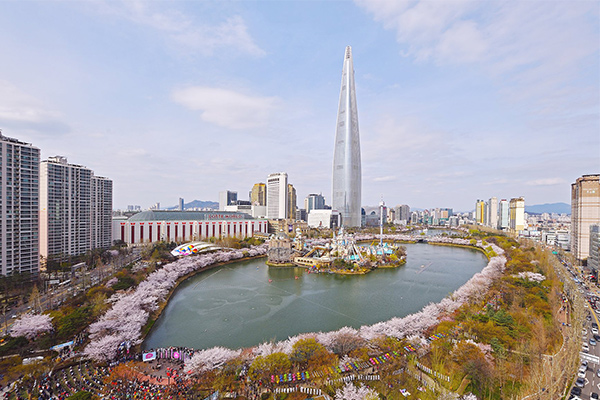Construction of Seokchon Lake

In Patricia Park's Re Jane, a reimaging of Charlotte Brontë's Jane Eyre, Park emphasizes the theme of traditional values vs. the modern as she renders Jane in a constant struggle to come to an understanding with her uncle, Sang. As Jane is pressured to take on new language, discourse, and mentalities by both Beth and Ed of the Mazer-Farley family, we see the rift between her and her Uncle's traditional values grow larger. Moments of reflection of both environmental and pop culture changes — often told through Sang's or Ed's dialogue — aim to highlight this rift between "the old" and "the new." During Jane's time dating Changhoon in Korea, it's mentioned that "thirty years ago" Seokchon Lake (a romantic date spot for the couple) "didn't even exist" (Patricia Park 191). The history of this lake and the surrounding park is a reference to the rapid modernization of South Korea in the 1970s and is highly representative of the vast differences between Jane and many of the older characters in the story.
In the 1960s, South Korea under new control underwent rapid economic and industrial growth. The time, known as the "Miracle on the Han River," is primarily attributed to several infrastructural changes (creation of new roadways, water systems, and sewage systems) that occurred to bolster the city and its citizens (Cho and Kwon). Of these changes, the Han River in Seoul, Korea was divided to accommodate new roadways and structures. In its division, Seokchon Lake was singled out and (eventually) targeted as a site for beautification. Not only was the conception of the lake a turning point in Seoul's history, but so too was the years of modification following. While it later became a large site for tourism, it took the city several years to beautify it — the primary motive being the anticipation of the Seoul Olympic games which were forthcoming in 1988 (Moonho Park). In the lake's earlier years (1970s) the quality of both the water and surrounding area was poor, suffering from sewage pollution and limited recreational space. Then, in the early 1980s, the lake's potential was fully realized with the construction of a surrounding park and accompanying recreational structures ("Seokchon Lake"). Today it's recognized as a major tourist attraction and an interest site for ecology restoration efforts (Moonho Park; "Seokchon Lake").
The brief but important emphasis of this lake in Park's novel suggests an inclination towards the "modern," or the mentality that Jane encompasses. As the text allows us to recognize a point of comparison between Jane and her elders, the history of the lake — that which favors the modern-day version as opposed to its older state — emphasizes the importance and advantageous nature of new age thinking. As a secondary function, it allows us to visually picture the environments that have informed the different mentalities held by Jane and her older family members. Those, like Big Uncle, who remember the lake before it was and the conditions that accompanied it, are haunted by a cautiousness that those who only know the lake as it is now can never understand. It is the same discrepancy emphasized by Sang's confusion of "old" vs. "new" Korea from earlier chapters.
Works Cited
Cho, Wonjun and Kwon, Youngsang. "The Era of Seoul's rapid growth (1960's–1970's): The role of ex-military elite mayors." Cities, vol. 110, March 2021. https://www.sciencedirect.com/science/article/pii/S0264275120314219. Accessed 3 April 2022.
Park, Moonho. "Seoul – 5.1 The Miracle on the Han River: Accomplishments and Shortcomings." CEFIA, 19 January 2017. http://cefia.aks.ac.kr:84/index.php?title=Seoul__5.1_The_Miracle_on_the_Han_River: Accomplishments_and_Shortcomings. Accessed 3 April 2022.
Park, Patricia. Re Jane. New York, New York. Penguin Publishing Group, 2015.
"Seokchon Lake." Doosan Encyclopedia. https://terms.naver.com/entry.naver?docId=1285698&cid=40942&categoryId=34709. Accessed 3 April 2022.
